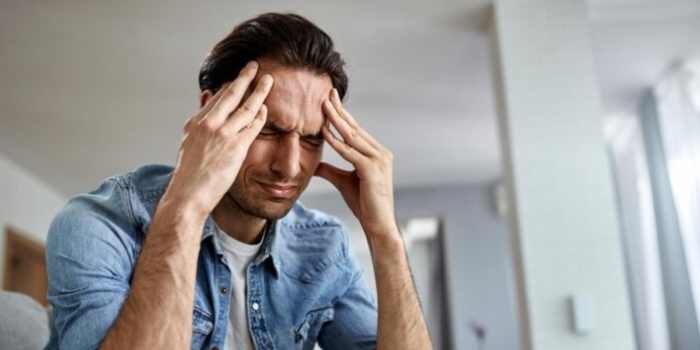Why Do Noise-Canceling Headphones Give Me Headaches? While noise-canceling headphones provide a respite from the chaos of the outer world, some users experience headaches after extended use.
Understanding the fundamental causes of this pain requires digging into the complex mechanisms of both the headphones and our physiological responses. This syndrome is caused by a variety of reasons, including pressure imbalances and sensory overload.
Exploring these nuances can assist users in reducing discomfort and maximizing the benefits of their noise-cancelling headphones.
The Unexpected Headache of Noise-Canceling Headphones
In this topic we will cover:-
- Headaches Caused by Noise-Canceling Headphones
- How to Choose the Right Noise-Canceling Headphones for You
- How to Wear Noise-Canceling Headphones Properly and Avoid Headaches
1. Headaches Caused by Noise-Canceling Headphones

Many people choose noise-canceling headphones because they allow them to focus on their music or work without being distracted by the outside world. However, as with any technology, they have their own set of potential downsides, including the risk of producing headaches. Let us explore deeper into this topic.
Types of Headaches Caused by Noise-Canceling Headphones
Tension Headaches
Tension headaches are among the most common symptoms reported by those who use noise-canceling headphones. They frequently present as a dull, persistent discomfort around the temples or back of the head.
Migraines
For some users, particularly those sensitive to sensory stimuli, noise-canceling headphones can trigger migraines characterized by throbbing pain, nausea, and sensitivity to light and sound.
Pressure Headaches
The sensation of pressure around the head, akin to sinus pressure, can also occur due to prolonged use of noise-canceling headphones.
How Noise-Canceling Headphones May Cause Headaches:
Increased Intracranial Pressure
Noise-canceling headphones create a sealed environment around the ears, which, over time, can lead to increased pressure within the skull, potentially triggering headaches.
Ear Canal Sensitivity
Some individuals may experience discomfort or pain in the ear canal due to the constant pressure exerted by noise-canceling headphones, leading to headaches.
Overstimulation
The continuous use of noise-canceling headphones, especially at high volumes, can overstimulate the auditory system, contributing to headaches and migraines in susceptible individuals
How to Avoid Headaches From Noise-Canceling Headphones
Take regular breaks To lessen the pressure on the auditory system and the danger of headaches, take regular breaks from wearing noise-canceling headphones and allow your ears and head to rest.
Maintain a modest volume level on your headphones. Excessive volume can cause sensory overload and raise the risk of headaches.
Select Comfortable Headphones: Choose noise-canceling headphones with adjustable headbands to reduce pressure points and ensure a secure fit.
Limit Headphone Usage: Use headphones for a limited time, especially in noisy places where noise-cancelling functions may be overused.
Seek practitioner Help: If headaches persist, see a healthcare practitioner or audiologist for individualized guidance and to rule out any underlying causes.
2. How to Choose the Right Noise-Canceling Headphones for You

When it comes to finding the best noise-canceling headphones for your needs, there are a few key elements to consider to ensure a good audio experience. Let us go deeper into each area.
Consider Your Noise Sensitivity.
Assess Your Environment: Consider where you plan to use your headphones the most. If you frequently find yourself in noisy places, such as airports or hectic city streets, choose headphones with superior noise-cancelling qualities.
Active vs. Passive Noise Cancellation: Determine whether you require active noise cancellation (ANC) or if passive noise isolation is sufficient. ANC headphones use microphones to actively counteract environmental noise, whereas passive noise isolation depends on physical barriers such as earcup cushioning.
Customizable Noise Cancellation Levels: Some headphones have customizable noise cancellation settings, which allow you to tune the intensity of noise suppression to your surroundings.
Select the Right Fit
Consider whether you prefer over-ear or on-ear designs. Over-ear headphones wrap the ears, giving superior noise isolation and comfort for extended usage, whereas on-ear headphones rest directly on the ears and have a more compact form.
Adjustable Headband: Choose headphones with an adjustable headband to ensure a secure and comfortable fit, accommodating a wide range of head sizes without causing discomfort during extended use.
Swiveling or rotating ear cups increase flexibility and comfort by allowing the headphones to adjust to your head shape and relieve pressure spots.
Look for comfort features.
Memory Foam Cushions: Headphones with memory foam ear cushions give improved comfort by conforming to the shape of your ears, relieving pressure and increasing noise isolation.
Breathable Materials: Look for headphones made from breathable materials to avoid discomfort from heat accumulation during long listening sessions.
Lightweight Design: Choose lightweight headphones to reduce pressure on your head and neck, especially if you intend to wear them for a lengthy time.
Adjustable Clamping Force: Some headphones have adjustable clamping force, which allows you to control the pressure applied by the ear cups for a snug but comfortable fit.
3. How to Wear Noise-Canceling Headphones Properly and Avoid Headaches

Check the fit of your headphones.
Find the Right Size: Ensure that your headphones are the proper size for your head. A snug but not overly tight fit is ideal.
Position the headband so that it fits comfortably on the top of your head without creating pressure points.
Ear Cup Placement: To ensure a proper seal, place the ear cups completely over your ears. This seal is critical for good noise cancellation and eliminating the requirement for higher volume levels.
Do not wear your headphones too loudly
loudness Control: Keep the loudness moderate. Excessively loud sounds might induce ear strain and headaches.
Use the Noise-Canceling Feature: Rather than turning up the volume excessively, use the noise-canceling technology to block out external sounds.
Observe Environmental Noise: If you find yourself frequently turning up the volume to drown out external noise, consider moving to a quieter setting or wearing noise-canceling headphones with earplugs for improved isolation.
Take breaks from wearing your headphones.
Follow the 60/60 Rule, which states that you should only listen for 60 minutes at 60% of the maximum volume. This helps avoid ear fatigue and lowers the likelihood of headaches.
Breaks: Every hour or so, take a 5- to 10-minute break from wearing headphones. This helps your ears to relax and heal after prolonged exposure to acoustic stimulation.
Engage in quiet activities. During breaks, do calm activities like stretching, walking, or simply sitting in peace to allow your ears to rest.
Staying hydrated can improve overall comfort and reduce the risk of headaches.
Monitor Symptoms: If you develop discomfort, ringing in your ears (tinnitus), or headaches while wearing noise-canceling headphones, stop using them and seek medical attention.
Frequently Asked Questions
1. Why do noise-canceling headphones give me a headache?
- Noise-canceling headphones use active technology to block out external sounds by producing anti-noise signals. This process can create pressure on the eardrums, leading to discomfort and headaches for some individuals.
2. Can everyone experience headaches from noise-canceling headphones?
- No, not everyone will experience headaches from using noise-canceling headphones. Sensitivity to pressure changes and prolonged use can contribute to headaches in certain individuals.
3. Are there specific conditions that make people more prone to headaches from noise-canceling headphones?
- Yes, factors such as pre-existing headaches or migraines, sensitivity to changes in air pressure, and prolonged use of noise-canceling headphones can increase the likelihood of experiencing headaches.
4. How can I minimize the risk of getting a headache while using noise-canceling headphones?
- Take regular breaks from using noise-canceling headphones, adjust the volume to a comfortable level, and ensure the headphones fit properly to reduce pressure on the ears. Additionally, consider using them in quieter environments or opting for noise-isolating headphones instead.
Conclusion
Finally, there are various reasons why noise-canceling headphones can cause headaches. For starters, the pressure exerted by active noise-canceling technology on the eardrums can cause discomfort and headaches, particularly when worn for long periods of time.
Furthermore, seclusion from ambient sounds might cause a confusing experience, aggravating headaches for some people. Furthermore, the presence of low-frequency disturbances that the headphones do not effectively filter out can cause discomfort.
Users must be mindful of their unique sensitivities and use noise-canceling headphones in moderation to reduce the risk of headaches. Furthermore, examining various headphone options or modifying settings to lessen pressure may benefit those who suffer from headaches.
Finally, while noise-canceling headphones can help reduce external distractions, users should prioritize their own comfort and well-being to ensure a pleasant listening experience.

